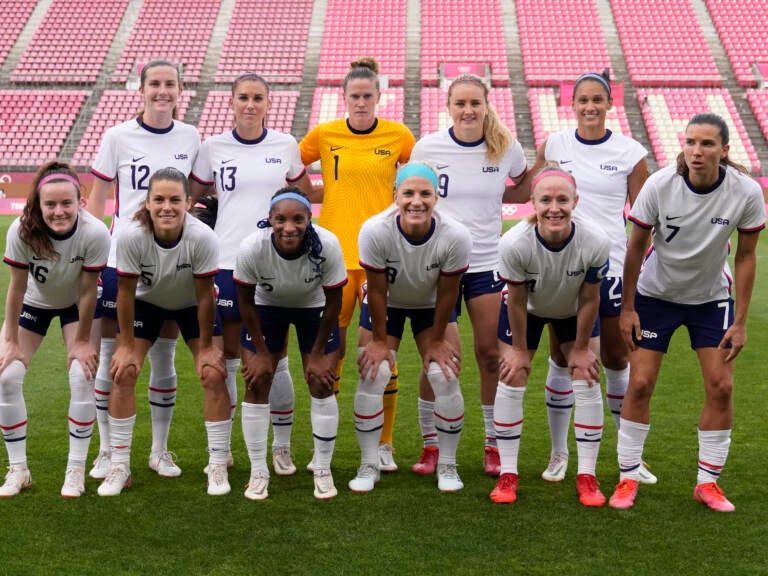On Equal Pay Day, women are trying to make a dollar out of 83 cents

On Tuesday, members of of the U.S. National Women's Soccer team, pictured at the 2020 Tokyo Summer Olympics, marked Equity Pay Day in a panel discussion with Vice President Kamala Harris. (Fernando Vergara/AP)
Equal Pay Day in the U.S. lands on a different day every year, and this year it turns out on average, women “only” had to work 74 extra days into 2022 to catch up to what men earned in 2021.
That day is March 15, the earliest the occasion has ever been marked.
It’s an incremental achievement – falling eight days earlier than last year – that was noted on Tuesday by Vice President Kamala Harris, who appeared alongside players of the U.S. national women’s soccer team, which recently won a yearslong legal battle for equal working conditions and fair compensation.
“Obviously, you all have been champions in terms of your skill and your dominance in terms of women’s soccer but we are here today because you also have been leaders on an issue that affects most women and have affected most women in the workforce, and it’s the issue of pay equity,” Harris said kicking off the panel.
The soccer team reached a $24 million settlement in its class action equal pay lawsuit against the U.S. Soccer Federation last month.
Harris praised the players for their victory and for leading a national conversation about pay discrimination, which she noted remains woefully widespread.
The Institute for Women’s Police Research reports that women who worked year round in full-time jobs in the U.S. were paid just 83 cents on the dollar compared with men. That’s up a whopping penny from last year.
There is no data available on the earnings of transgender men and women or nonbinary people.
“This Equal Pay Day, it is clear that pay equity remains elusive for many women regardless of their occupation or sector,” C. Nicole Mason, President and CEO of the Institute for Women’s Policy Research, said in a statement.
“As women re-enter the workforce, they label higher pay as a key priority when seeking out new opportunities — highlighting the important role employers have to play in accelerating the closing of the gender pay gap,” Mason added.
The news is even more grim when comparing all women who worked in 2020 with all men who worked, regardless of the number of hours and weeks they clocked. In that instance, women were typically paid just 77 cents on the dollar.
But data shows that those who get the worst end of the wage-gap stick are women of color, who are disproportionately represented in minimum-wage and low-wage jobs. The Institute reports that while the wage gap narrowed for all women compared to all men, the wage gap widened for Asian, Black, and Hispanic women.
The National Women’s Law Center, which conducted its own research using data from 2020, says “unequal pay pervades 94 percent of occupations, and shortchanges women hundreds of thousands of dollars over the course of a 40-year career.”
Over their lifetimes, Latinas working full-time, year-round stand to lose more than $1.1 million, and Black women will miss out on close to $1 million.
The Biden administration has said it is set on ending the gender pay gap for federal workers and contractors. On Tuesday, Biden issued an executive order that would prevent federal agencies from asking about an applicant’s salary history in the hiring process.
“Pay transparency creates accountability and accountability, well, that drives progress,” Harris said about the order, adding that it will help “build a more fair, more efficient, and more equitable economy.”
9(MDAzMzI1ODY3MDEyMzkzOTE3NjIxNDg3MQ001))




